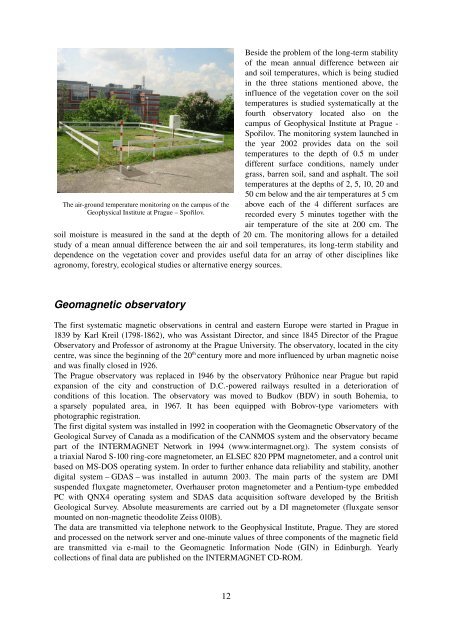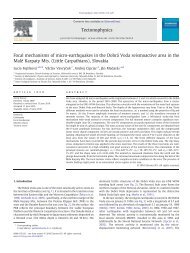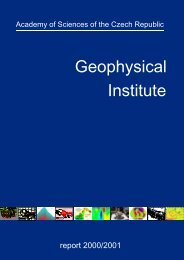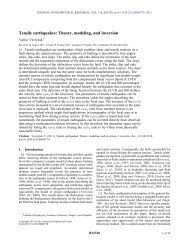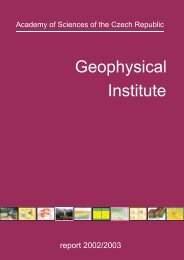Geophysical Institute of the ASCR
Geophysical Institute of the ASCR
Geophysical Institute of the ASCR
You also want an ePaper? Increase the reach of your titles
YUMPU automatically turns print PDFs into web optimized ePapers that Google loves.
The air-ground temperature monitoring on <strong>the</strong> campus <strong>of</strong> <strong>the</strong><br />
<strong>Geophysical</strong> <strong>Institute</strong> at Prague – Spořilov.<br />
Beside <strong>the</strong> problem <strong>of</strong> <strong>the</strong> long-term stability<br />
<strong>of</strong> <strong>the</strong> mean annual difference between air<br />
and soil temperatures, which is being studied<br />
in <strong>the</strong> three stations mentioned above, <strong>the</strong><br />
influence <strong>of</strong> <strong>the</strong> vegetation cover on <strong>the</strong> soil<br />
temperatures is studied systematically at <strong>the</strong><br />
fourth observatory located also on <strong>the</strong><br />
campus <strong>of</strong> <strong>Geophysical</strong> <strong>Institute</strong> at Prague -<br />
Spořilov. The monitoring system launched in<br />
<strong>the</strong> year 2002 provides data on <strong>the</strong> soil<br />
temperatures to <strong>the</strong> depth <strong>of</strong> 0.5 m under<br />
different surface conditions, namely under<br />
grass, barren soil, sand and asphalt. The soil<br />
temperatures at <strong>the</strong> depths <strong>of</strong> 2, 5, 10, 20 and<br />
50 cm below and <strong>the</strong> air temperatures at 5 cm<br />
above each <strong>of</strong> <strong>the</strong> 4 different surfaces are<br />
recorded every 5 minutes toge<strong>the</strong>r with <strong>the</strong><br />
air temperature <strong>of</strong> <strong>the</strong> site at 200 cm. The<br />
soil moisture is measured in <strong>the</strong> sand at <strong>the</strong> depth <strong>of</strong> 20 cm. The monitoring allows for a detailed<br />
study <strong>of</strong> a mean annual difference between <strong>the</strong> air and soil temperatures, its long-term stability and<br />
dependence on <strong>the</strong> vegetation cover and provides useful data for an array <strong>of</strong> o<strong>the</strong>r disciplines like<br />
agronomy, forestry, ecological studies or alternative energy sources.<br />
Geomagnetic observatory<br />
The first systematic magnetic observations in central and eastern Europe were started in Prague in<br />
1839 by Karl Kreil (1798-1862), who was Assistant Director, and since 1845 Director <strong>of</strong> <strong>the</strong> Prague<br />
Observatory and Pr<strong>of</strong>essor <strong>of</strong> astronomy at <strong>the</strong> Prague University. The observatory, located in <strong>the</strong> city<br />
centre, was since <strong>the</strong> beginning <strong>of</strong> <strong>the</strong> 20 th century more and more influenced by urban magnetic noise<br />
and was finally closed in 1926.<br />
The Prague observatory was replaced in 1946 by <strong>the</strong> observatory Průhonice near Prague but rapid<br />
expansion <strong>of</strong> <strong>the</strong> city and construction <strong>of</strong> D.C.-powered railways resulted in a deterioration <strong>of</strong><br />
conditions <strong>of</strong> this location. The observatory was moved to Budkov (BDV) in south Bohemia, to<br />
a sparsely populated area, in 1967. It has been equipped with Bobrov-type variometers with<br />
photographic registration.<br />
The first digital system was installed in 1992 in cooperation with <strong>the</strong> Geomagnetic Observatory <strong>of</strong> <strong>the</strong><br />
Geological Survey <strong>of</strong> Canada as a modification <strong>of</strong> <strong>the</strong> CANMOS system and <strong>the</strong> observatory became<br />
part <strong>of</strong> <strong>the</strong> INTERMAGNET Network in 1994 (www.intermagnet.org). The system consists <strong>of</strong><br />
a triaxial Narod S-100 ring-core magnetometer, an ELSEC 820 PPM magnetometer, and a control unit<br />
based on MS-DOS operating system. In order to fur<strong>the</strong>r enhance data reliability and stability, ano<strong>the</strong>r<br />
digital system – GDAS – was installed in autumn 2003. The main parts <strong>of</strong> <strong>the</strong> system are DMI<br />
suspended fluxgate magnetometer, Overhauser proton magnetometer and a Pentium-type embedded<br />
PC with QNX4 operating system and SDAS data acquisition s<strong>of</strong>tware developed by <strong>the</strong> British<br />
Geological Survey. Absolute measurements are carried out by a DI magnetometer (fluxgate sensor<br />
mounted on non-magnetic <strong>the</strong>odolite Zeiss 010B).<br />
The data are transmitted via telephone network to <strong>the</strong> <strong>Geophysical</strong> <strong>Institute</strong>, Prague. They are stored<br />
and processed on <strong>the</strong> network server and one-minute values <strong>of</strong> three components <strong>of</strong> <strong>the</strong> magnetic field<br />
are transmitted via e-mail to <strong>the</strong> Geomagnetic Information Node (GIN) in Edinburgh. Yearly<br />
collections <strong>of</strong> final data are published on <strong>the</strong> INTERMAGNET CD-ROM.<br />
12


